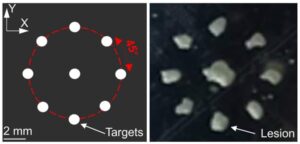Bacteria that take up single-walled carbon nanotubes (SWCNTs) continue to divide as normal and even pass on the resulting extra capabilities to their descendants. This result, which was recently demonstrated by researchers at the EPFL in Switzerland, forms the basis of a new field they call “inherited nanobionics”. The researchers believe the modified bacteria could be used to make living photovoltaics – energy-producing devices that they say could provide “a real solution to our ongoing energy crisis and efforts against climate change”.
SWCNTs are rolled-up sheets of carbon just one atom thick, with a total diameter of about 1 nm. They boast excellent electrical, optical and mechanical properties that make them ideal for many applications in the field of nanobiotechnology. Researchers have, for example, placed these nanostructures in mammalian cells to monitor metabolism using near-infrared light emitted by the nanotubes. The light emitted can also be used to image biological tissue deep inside the body and help deliver therapeutic drugs into cells. In plant cells, SWCNTs have even been used to edit genomes.
SWCNT take-up is passive, length-dependent and selective
In the new work, researchers led by Ardemis Boghossian began by wrapping SWCNTs with a positively-charged protein coating. The nanostructures were then able to interact with the negatively charged outer membranes surrounding the bacterial cells they studied, which come from the genus Synechocystis and Nostos. The former is unicellular and spherical while the latter is multicellular and has a snake-like shape. Both are Gram-negative bacteria (so-called because they have a thin cell wall as well as an additional outer membrane, meaning that they do not retain the dye used in a common test known as a Gram stain), and they belong to the Cyanobacteria phylum. This group of bacteria obtain their energy though photosynthesis, like plants.
Boghossian and colleagues found that both Synechocystis and Nostos took up the SWCNTs through a passive, length-dependent and selective process that allows the nanoparticles to spontaneously enter the microorganisms’ cell walls. They also discovered that the nanotubes could be imaged very clearly in the infrared because they fluoresce in this region of the electromagnetic spectrum. Indeed, this light emission allowed the researchers to see that the SWCNTs were being passed on to the so-called daughter cells of the bacteria when they divide. The daughter cells thus inherit the exceptional properties of the nanotubes.
Like an artificial limb
“We call this ‘inherited nanobionics’,” explains Boghossian. “It’s like having an artificial limb that gives you capabilities beyond what you can achieve naturally. And now imagine that your children can inherit its properties from you when they are born. Not only did we impart the bacteria with this artificial behaviour, but this behaviour is also inherited by their descendants.”
And that was not all: the researchers also found that nanotube-containing bacteria produce a significantly greater amount of electricity when illuminated with light than do bacteria without nanotubes. “Such ‘living photovoltaics’ benefit from a carbon footprint that is negative – they actively take up, rather than release, carbon dioxide,” Boghossian tells Physics World. “This is in contrast to conventional photovoltaics, which while taking advantage of our most abundant energy source – the Sun – generate a lot of carbon dioxide during the manufacturing stage.” This is the “dirty secret” of photovoltaics, she says.
Living photovoltaics also have other important advantages: they have automated mechanisms for optimizing light absorption; can self-repair; and importantly, can reproduce, she adds. “You don’t have to worry about building a factory to manufacture each individual cell. These cells use the carbon dioxide they take up to automatically repair and make more of themselves. They rely on earth-abundant materials, and they are cheap. This is a materials science dream.”
Application areas
The work, which is detailed in Nature Nanotechnology, highlights applications that focus on light-harvesting as well as fluorescence imaging. “The imaging, for example, not only allows us to track the cells across generations, we are also able to use this technology to differentiate between living and non-living cells, and different cell types.” Boghossian says.

Graphene ‘drums’ pick up vibrations from individual bacteria
The researchers could even track the formation of different parts of the bacterial membranes after cell division thanks to the light emitted by the nanotubes and monitor physicochemical changes inside the cells. “What is special about this application is that the emitted light is distinct from the light that is naturally emitted by the cells, so we do not have to worry about interfering signals that have limited other such technologies,” Boghossian says.
Being able to introduce CNTs into bacteria in this way could also lead to new applications in therapeutics or DNA delivery that were previously hindered by the difficult-to-penetrate bacterial cell walls.
The EPFL team is now studying ways of re-programming their bacterial cells to produce electricity by modifying their DNA. “Light-harvesting organisms are naturally not very efficient at producing electricity,” explain Boghossian. “This is because they have been engineered by Nature for survival, not photovoltaics. With the recent expansion of synthetic biology, we’re now in a position to re-purpose these cells so that they are genetically inclined to produce electricity.”













